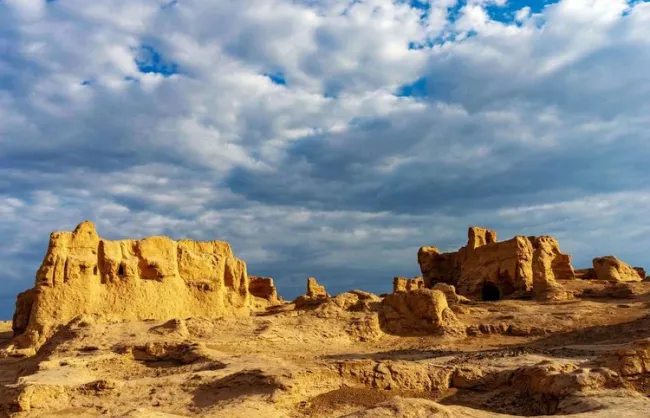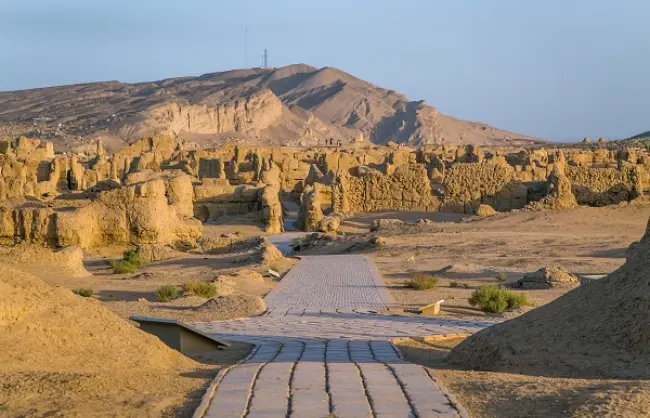Concealed deep in the Xinjiang interior, Jiaohe ruins lures tourists with its stunning earthen architecture and its abundance of historical context. Far from being a simple ancient town, it was a clever solution to the unusual set of challenges facing Turpan Depression’s inhabitants, which just so happens to be the world’s second-lowest point.
Scorching temperatures and evaporation are no joke. Traditional irrigation plans are out of the question. In this case, a clever irrigation system was devised that brought mountain runoff into the plains.
Entering Jiaohe Ancient City means entering history again. Each relic speaks words about the past, and each cobblestone lane tells stories about ancient times. When tourists stride along the original city walls, streets, and temples, they feel that they have walked in from the future to visit in the past for a glimpse at the magnificence of Western Regions.
For history enthusiasts and adventure-seeking tourists alike, Jiaohe ruins offers an unparalleled glimpse into the past, and therefore are a sight not to be overlooked on any trip to Xinjiang or Turpan.
Jiaohe Ruins Facts
- Location: Situated in the Yarnaz Valley, 10 kilometers west of Turpan City, in Xinjiang’s autonomous region, northwestern China.
- History: Over 1,300 years.
- Ticket Price: CNY 70
- Area:Spanning 30,000 square meters, comprising several ancient buildings and structures.
- Opening Hours:
- High season (Apr 21 – Oct 20): 8:00 am – 9:00 pm.
- Low season (Oct 21 – Apr 20): 10:00 am – 6:30 pm.
- Time Needed: Half-day to full day.
- Highlights: Concubine Palace of the Front, Temple of Fire, Great Mosque, houses of residence.
- Recommended for: History buffs, people who love culture, architecture buffs.

History of Jiaohe Ruins
Jiaohe ruins, found in the western suburbs of today’s Turpan City in Xinjiang Uygur Autonomous Region, china silk road travel spot has a history dating back to ancient times.
Jiaohe ruins in around 300 BC, the discovery of Caucasian remains in nearby graves surprised researchers, showing close links between the early inhabitants of the Jiaohe ancient city and the Caucasians, especially those residing in the town of Chishi.
At some point in 100 BC, the Han Dynasty began trading relations with Western states for the purpose of dominating the Silk Road and securing oneself against foes. Around 60 BC, Jiaohe ruins saw Chishi become part of the Han Empire, in which approximately a thousand troops were stationed there to ensure peace.
With the weakening of the Han Dynasty around 200 AD, as the empire collapsed, so did Jiaohe ancient city experience numerous royal transitions before falling to a general of the Tang Dynasty in 640 AD and being incorporated into Tang land. Most of the structures that still stand today date back to the Tang dynasty.
Historical accounts have it that Jiaohe ruins had a population of 7,000 in the 8th century, and this provides proof of the prosperous civilization of ancient city of Jiaohe.
How Jiaohe Ruins Was Built
Jiaohe ruins, which occupy an island-shaped terrace 13 kilometers to the west of Turpan City, is a fascinating flashback to the past. Jiaohe ruins was so named because it has a river encircling the settlement. Bird’s eye perspectives reveal that Jiaohe ruins resembles a level boat resting in nature’s crease. Jiaohe ancient city, nestled between cliffs, has three city gates intricately carved into the eastern, western, and southern cliff faces.
Missing are the traditional city walls, and outstanding is the fact that most of the buildings, large and small, are professionally cut out from the surface of the towering terrace using the “cutting earth to leave walls” method. Temples, governmental buildings, city gates, and houses are all made largely of adobe walls. The streets, which are deep and narrow, look like serpentine trenches, enhancing the beauty of this old settlement.
In essence, Jiaohe ruins is a colossal ancient sculpture, a must-visit for those embarking on china silk road travel. For those in Turpan, a visit to Jiaohe ruins turpan promises an unforgettable experience steeped in history.
√Related reading: The Silk Road Stories
What to See and Do in Jiaohe Ruins
Jiaohe ruins offer a unique blend of history, culture, and architecture that make it a must-visit destination. Here are some must-see attractions:
Uncovering Jiaohe Ruins——The Front Palace
Amidst the Jiaohe ruins is the Former Concubine Palace, familiarly known as the Former Palace. This Former Concubine Palace is a product of the Tang Dynasty (618-907 AD) and exemplifies the refinement and majesty of the aristocracy during those times. Visit the Jiaohe ruins to discover this well-preserved palace.
Appreciating Art at Jiaohe Ruins——The Flame Temple
Inside the Jiaohe ruins lies the Flame Temple, a Tang Dynasty Buddhist complex known for its stunning murals and sculptures. The artworks are significant in highlighting the Buddhist art and culture of the Tang Dynasty.

Taking a stroll——The Grand Mosque
The Grand Mosque, one of the Yuan Dynasty (1271-1368) gems of the Jiaohe ruins, is an exemplar of Islamic architecture. Its ornamentation gives proof of Islam’s prosperity during that era.
Uncovering Residential Life
Travel back in time to the lives of ancient people by walking along the preserved houses of Jiaohe ruins. These structures reveal the residential life, house designs, and construction techniques of Jiaohe ancient ruins dwellers.
Revealing Ancient Engineering——The Ancient Well
In the Jiaohe ruins silk road location, you can find old well systems important for accessing water. Notice the deep grooves excavated at the well’s mouth, a quiet witness to the ingenuity and perseverance of old inhabitants.
Best time to visit
April to October is the best time for turpan travel to Jiaohe ruins of Xinjiang. The local climate is warm at this point, avoiding both heat and cold extremes, making it a pleasant experience.
For people who wish to have memorable experiences, a visit to the Jiaohe ruins in the evening is particularly suggested. At dusk, the ancient walls glimmer with mystical colors of yellow and red, contrasting against the desert background, making it a stunning sight.
In order to take this lovely vista of Xinjiang tours, it is best to arrive on the bus at 5 PM to avoid the intense midday sun and have time to photograph the ruins in a soft, golden light. The Jiaohe ruins silk road brings another historical experience to the backdrop of turpan tours.
Attractions Near Jiaohe Ruins
- Karez Well System:Just off the Jiaohe ruins, this system amazes with its ancient construction, bringing mountain water to parched plains. Don’t pass up the chance on the Xinjiang travel
- Turpan Museum: In the heart of Turpan City, this museum houses a treasure trove of artifacts and paintings, proving the history and culture of Turpan, with details regarding the Jiaohe ancient ruins.
How to Get to Jiaohe Ruins
- By Bus:People can take bus No. 1 or No. 101 to Turpan’s Xincheng Road stop.
- By Taxi:Jiaohe ruins is just 10 kilometers (6.2 miles) from Turpan City. It will only take 15 minutes by taxi and it will cost just 20 yuan.
Recommended Xinjiang Tours to Jiaohe Ruins
- 7 Days Classic Xinjiang Tour from Kashgar
- 11 Days Northern Xinjiang In-depth Tour
- 12 Days Xinjiang Silk Road Tour for Nature and Culture Tracing









